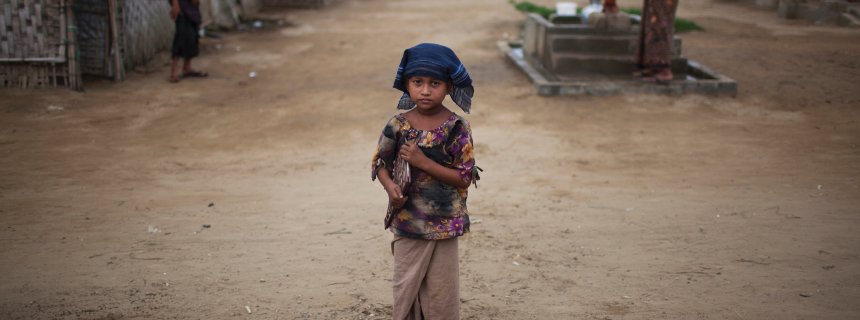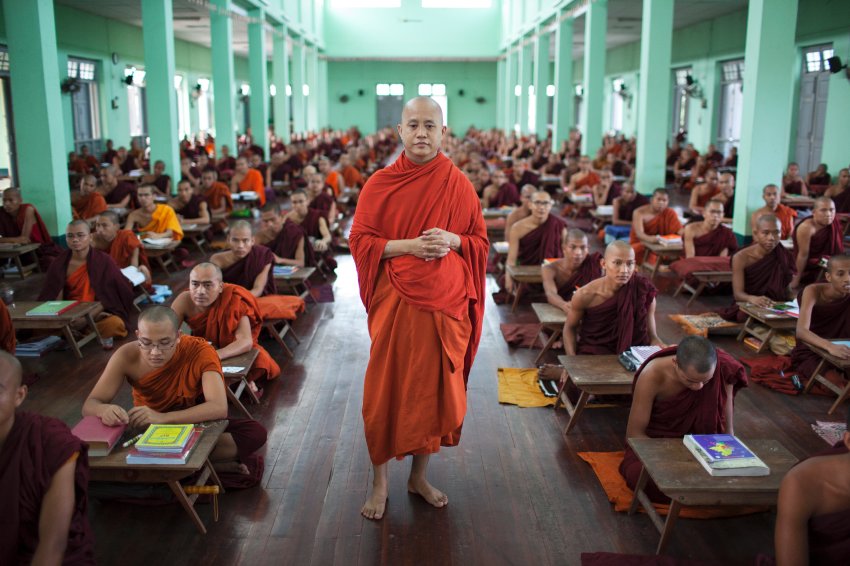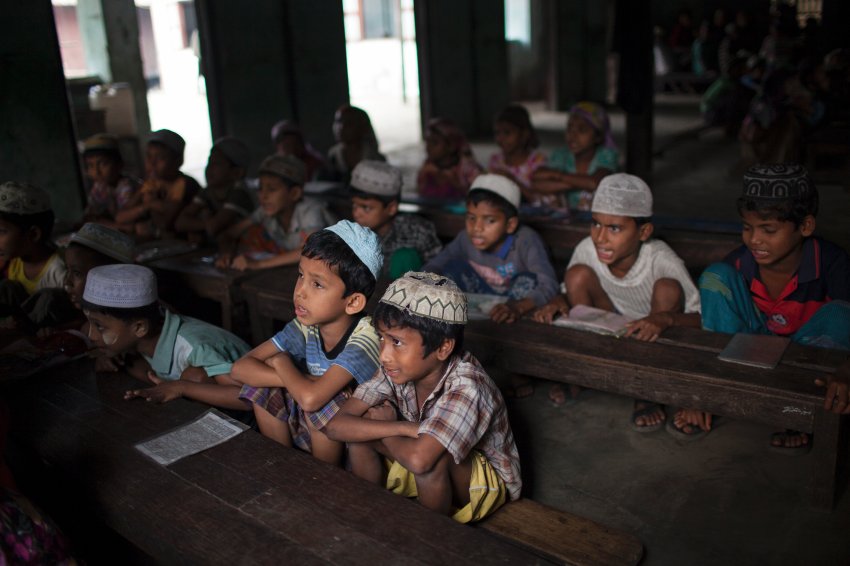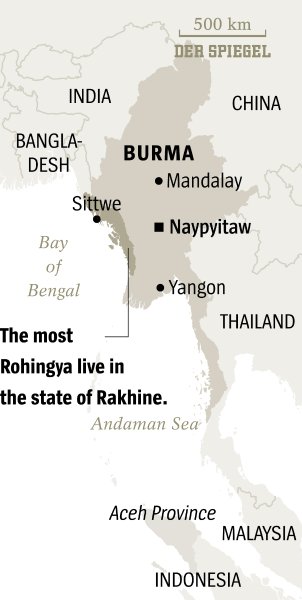Burma’s Stateless Muslims: The World’s Most Persecuted Minority
ASIA--PACIFIC, 8 Jun 2015
Katrin Kuntz in Sittwe – Der Spiegel
In Burma, thousands of members of the Rohingya Muslim minority are fleeing persecution from Buddhists. Abused by smugglers, they are being turned away from Malaysia, Indonesia and Thailand.

A Rohingya girl clutches a schoolbook at the Baw Du Pa camp in Sittwe Township, Myanmar (Burma), May 23, 2015.
Nuralam often sits awake for hours at night when a lukewarm wind blows through the hut, carrying with it the smell of the sea. He peers over at his sister lying next to him on the mat. He sees his brother at his feet and his mother, both of whom are sleeping. If he were to run to the sea as he once did and surrender himself to it facing in the direction of Malaysia, as he once did, then he would have to leave them all alone here, in a refugee camp in western Burma.
Of course they would miss him. But wouldn’t this provide his siblings with more room in the hut? And couldn’t Nuralam — a 23-year-old diminutive young man with a quiet voice and an ankle-length cloth wrapped around his waist — finally become a real person? “A person with work,” he says. “And with rights.”
As a member of the Rohingya Muslim religious minority, he is not recognized by his country as a citizen. In recent years, radical Buddhists have been agitating people against his religion. Even though he was born in Burma, the authorities refer to him as a “Bengal.”
What keeps a man like Nuralam in a country in which he is stateless and won’t even give him a passport? With a lack of anything better to do, it is a thought that has preoccupied Nuralam countless times in the camp.

Ashin Wirathu walks through a class of Buddhist monks at the Masoeyein monastry in Mandalay, Myanmar (Burma), May 25, 2015.
Ashin Wirathu, a monk, has been described as a “Burmese bin Laden” and the “Face of Buddhist Terror” in the media. He was sentenced to seven years in jail for inciting hatred towards Muslims in Burma, but he was released early through an amnesty program.
During his walks, he has repeatedly seen naked children standing and playing in the sewage. So far this year, more than 25,000 Rohingya have fled in boats across the Gulf of Bengal. The images of their desperate odyssey off the coast of Thailand, Malaysia and Indonesia have been transmitted around the world. “I wanted to be one of them,” Nuralam says.
On the night of April 14, when everyone was asleep, Nuralam stood up on his mat. He walked quietly out the door and ran down to the beach. He had made an appointment with a smuggler who was waiting for him there. Nuralam didn’t know what odyssey he was about to embark on. He just wanted to put the insanity in Burma behind him for good.
The fact that camps are controlled by the Buddhists means that classrooms are left without teachers and clinics without doctors.

Rohingya children study at a school in the Aung Mingalar ghetto in Sittwe Township, Myanmar (Burma), March 25, 2015.
No Man’s Land
Nuralam, his three siblings and his mother have been living for the past three years in Camp Bawdupa, a facility for expelled Rohingya in Sittwe, the capital of the state of Rakhine. Rakhine is one of the country’s poorest states, a no man’s land that is home to around 3 million people, including close to a million members of the Rohingya minority. Some 140,000 of them are forced to live in ghetto-like villages that they are not allowed to leave.
Nuralam has been back at the camp for a week now. After weeks at sea, his effort to escape failed. It’s a morning in May and he is sitting in his hut, which is built on stilts. His mother would like to offer something to the guest, but there is nothing to give. “We are living in a jail here,” he says. He wants to tell the story of his life and his effort to escape.
His story began three years ago with an event that divided the lives of the Rohingya into before and after. In May 2012, a group of Muslims in Rakhine was accused of raping and murdering a Buddhist woman. Afterwards, Buddhists burned down Muslim villages in retaliation. Hundreds of people died and thousands fled, and many have been living in camps since then.
At the time, Nuralam was working as a rickshaw driver in a city called Sittwe. He never went to school. When he went home on July 8, 2012, he found his neighbor lying in front of the house — her decapitated head next to her body. Nuralam had witnessed the Buddhists herd together the Rohingya. As they set homes ablaze, Nuralam hid in the bushes. That night he ran away from the district where they lived in Sittwe. The government assigned him a place to live in a camp.
Burma’s Inner Turmoil
The state of Rakhine is reflective of Burma’s inner turmoil. On the one hand, you have a country that has opened up since President Thein Sein entered into office in March 2011 after nearly 50 years of military dictatorship. Aung San Suu Kyi’s National League for Democracy obtained official recognition as an opposition party, political prisoners were freed and the West lifted most sanctions against the country. For a time, at least, Burma appeared to be one of the few encouraging stories developing around the world. But the reforms soon stalled — and the wave of violence against the Rohingya began.
During the fragile political transition to democracy in recent years, the government has rekindled the old conflict. Burma’s identity is defined to a large degree by religion, and many Buddhists believe that the Muslim Rohingya were first brought to the country through its former British colonial rulers. They feel threatened by them.
In fact, the Muslim community has existed in Burma since the 16th century. During the British colonial period, Muslims also came as workers. When Burma became independent in 1948, Muslims represented the majority in many areas in Rakhine, but the Buddhists accused them of having aided the British. In 1982, the Rohingya were refused Burmese citizenship and discrimination against them continues today.
 The United Nations has described the Rohingya as one of the world’s most persecuted minorities. Even Aung San Suu Kyi, the Nobel Peace Prize recipient who was held under house arrest for years by the military is silent about Rohingya. It’s likely she doesn’t want to jeopardize votes in parliamentary elections planned for the fall, as if the sole mention of their name could somehow mean calamity. Human rights organizations that once campaigned on Suu Kyi’s behalf are now criticizing her. When asked about the Rohingya, Suu Kyi’s spokesman says, “They are immigrants, Bengalis.”
The United Nations has described the Rohingya as one of the world’s most persecuted minorities. Even Aung San Suu Kyi, the Nobel Peace Prize recipient who was held under house arrest for years by the military is silent about Rohingya. It’s likely she doesn’t want to jeopardize votes in parliamentary elections planned for the fall, as if the sole mention of their name could somehow mean calamity. Human rights organizations that once campaigned on Suu Kyi’s behalf are now criticizing her. When asked about the Rohingya, Suu Kyi’s spokesman says, “They are immigrants, Bengalis.”
‘Life Here Is Unbearable’
There are few traces of the work by international organizations in the camp where Nuralam now has to live. In 2014, Buddhists in Rakhine stormed the local offices of Doctors without Borders, smashed furniture and demanded that they be given half of all the aid. Now their committees control the camps, leaving schools without teachers and infirmaries where one can never be certain if a doctor is actually going to come. “Life here is unbearable for everyone,” Nuralam says.
Nuralam is familiar with the four race laws that are currently being discussed in parliament. One states that women must submit an application if they want to marry a Muslim man. Another would outlaw polygamy. In some regions, women will only be permitted to give birth to one child every three years. And those who want to switch religions must first apply with the state. President Thein Sein just signed the birth rule into law. Human rights activists fear that it could now be applied by regional governments in areas where Rohingya reside.
The smuggler who met Nuralam on the beach took him down the coast to a ship that had come from Thailand. Some 400 Rohingya from Burma and Bangladesh boarded the ship. More than 200,000 Rohingya live in Bangladesh, with most fleeing poverty. Outside on the water, when the crew pointed to a place for him on the deck, Nuralam says he began to cry as he thought of his sleeping mother. Still, he felt he was doing the right thing.
The smuggler had promised Nuralam a job at a factory in Malaysia and didn’t demand any money from him — at least initially. On the boat, the smuggler gave out rice, a glass of water and salt. He ordered the refugees to sit quietly. One day, when Nuralam went to the bathroom for a second time, one of the smugglers struck him with an iron chain. Nuralam was made to spend one month living in an area measuring one square meter, with his hands and feet bound — a man rolled into a ball and ready, at any time, to be swallowed by the sea.
Nuralam says that the refugees from Sittwe weren’t ordered to pay until they sought to disembark the boat. The going price for passage from Burma through the Andaman Sea to Thailand and then by land further to Malaysia is $2,000.
Extortion and Torture
Those who don’t have the money are held on the boat by the smugglers or taken to a shack in the jungle. They call up relatives of the refugees, pour scalding hot water on them or tear off fingernails in order to coerce the families into paying. Nuralam’s ship stopped just off the coast of Thailand. “I could see land,” he says, but Nuralam wasn’t allowed to leave the ship. Once again he was without a home, only this time on the high seas.
Human rights activists estimate that around 4,000 Rohingya are still stranded in boats. One of the problems here is that many Southeast Asian states are not signatories to the UN’s 1951 Refugee Convention. Just days ago, Indonesia and Malaysia made concessions and agreed to take in Rohingya for a year in a what equated to a stopgap emergency measure.
Since the beginning of May, when mass graves were discovered in Thailand — likely the remains of Rohingya — Thai authorities have tightened border controls. In recent days, further mass graves were discovered in the jungle in Malaysia, where bands of human-traffickers had detained hundreds of refugees and once again extorted their families to pay.
Nuralam’s older sister walks into the hut at the camp in Sittwe. She looks at her brother reproachfully as he explains how they anchored off the coast of Thailand for 10 days. Of how he feared he would die of thirst and hunger. Of how the Thai Navy forced the boat to turn around. How he then returned to Sittwe a week ago, weakened and filled with shame. And how his family is now $100 in debt for having to pay to get him freed from the boat.
“I will find a wife for Nuralam,” his sister says. “Because we belong to this country.” She’s making an allusion to the fact that the Rohingya can apply for a second-class citizenship if they can prove that their family has lived in Burma for longer than 60 years. But to get it, they also have to accept the name “Bengali”. It may appear to be a generous gesture on the part of the state, but the reality is that few Rohingya have identity papers.
And that’s just how the country’s Buddhist majority would like to see it, especially nationalist organizations like the 969 Movement, which has a great deal of influence in Burma. They hold that anyone who is not a Theravada Buddhist also can’t truly be Burmese.
Fomenting Hatred
In Mandalay in central Burma, Ashin Wirathu, 46, receives his visitor at the Ma Soe Yein Monastery. He’s a small and soft-spoken man with a gentle smile, but he has been called the “Burmese bin Laden” and, on the cover of Time magazine, the “Face of Buddhist Terror.” Wirathu was sentenced to jail for seven years for inciting hatred. Having been released through an amnesty program a few years ago, he now leaders 2,500 monks in Mandalay. But many view him as being a regime puppet.
On this particular morning, Wirathu sits in a red robe in a prayer room, with monks silently bowing before him. There are pictures in the next room of mutilated people — allegedly Buddhists killed by Muslims.
When asked what he considers to be his most important activities, he answers, “Facebook.” He has just posted photos of a Buddhist girl who was allegedly raped by a Muslim man. There’s also a Wirathu app and YouTube videos — he gives speeches across the entire country. Wirathu always talks about the same subject: His claim that the Rohingya want to take over Burma. He has the interview he conducts with SPIEGEL filmed. He says the step is not out of concern he might be misunderstood and assures that he doesn’t want anyone to die.
When asked what the 969 Movement wants, Wirathu, who has been a monk since he was 14, says, “We ensure Burma’s identity and religion.”
Asked what it is he has against the Rohingya, he says, “The Muslims are in the minority here, but they are also a threat to us: Charlie Hebdo, 9/11, the cafe in Australia, Syria, Nigeria, Kenya, Boko Haram, IS — just think about it. They want to turn the state of Rakhine into a Bengali republic.”
When asked why the Rohingya are fleeing, though, he remains silent.
Questioned about why the country isn’t helping the refugees, Wirathu says, “Burma has no responsibility for them. After all, stateless people cannot be refugees.” It’s an answer he seems quite pleased with. He claims that Saudi Arabia is financing the Rohingya.
A new day breaks in the Rohingya camp in Sittwe. Nuralam woke up at 5 a.m., fetched water at the well and wrapped areca nuts in betel leaves. He’s trying to find ways to make the day pass by. “I like wind,” he says, “and silence.”
Thinking about his future, Nuralam says he is considering selling chickens at the market with his brother-in-law. He says it would be good for them to earn a little bit of money for their mother. Personally, Nuralam says he doesn’t mind so much that he doesn’t own anything. He knows there are no opportunities for him in Burma. He wants to stay free and uncommitted. That also makes it easier to flee, he says.
DISCLAIMER: The statements, views and opinions expressed in pieces republished here are solely those of the authors and do not necessarily represent those of TMS. In accordance with title 17 U.S.C. section 107, this material is distributed without profit to those who have expressed a prior interest in receiving the included information for research and educational purposes. TMS has no affiliation whatsoever with the originator of this article nor is TMS endorsed or sponsored by the originator. “GO TO ORIGINAL” links are provided as a convenience to our readers and allow for verification of authenticity. However, as originating pages are often updated by their originating host sites, the versions posted may not match the versions our readers view when clicking the “GO TO ORIGINAL” links. This site contains copyrighted material the use of which has not always been specifically authorized by the copyright owner. We are making such material available in our efforts to advance understanding of environmental, political, human rights, economic, democracy, scientific, and social justice issues, etc. We believe this constitutes a ‘fair use’ of any such copyrighted material as provided for in section 107 of the US Copyright Law. In accordance with Title 17 U.S.C. Section 107, the material on this site is distributed without profit to those who have expressed a prior interest in receiving the included information for research and educational purposes. For more information go to: http://www.law.cornell.edu/uscode/17/107.shtml. If you wish to use copyrighted material from this site for purposes of your own that go beyond ‘fair use’, you must obtain permission from the copyright owner.